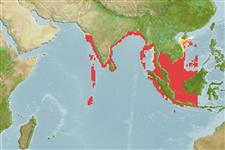>
Scombriformes (Mackerels) >
Scombridae (Mackerels, tunas, bonitos) > Scombrinae
Etymology: Scomberomorus: Latin, scomber = mackerel + Greek, moros = silly, stupid (Ref. 45335).
More on author: Cuvier.
Environment: milieu / climate zone / depth range / distribution range
Ecologie
marien; oceanodroom (Ref. 51243). Tropical; 24°N - 11°S, 70°E - 115°E (Ref. 168)
Indo-West Pacific: west coast of India and Sri Lanka eastward to Thailand, Malaysia and Java (Ref. 9684). Does not extend further out in the East Indies (Ref. 9684).
Lengte bij maturiteit / Grootte / Gewicht / Leeftijd
Maturity: Lm 70.0 range ? - ? cm
Max length : 94.0 cm FL mannelijk / geslacht onbekend; (Ref. 168); 98.0 cm (female); common length : 70.0 cm FL mannelijk / geslacht onbekend; (Ref. 9684)
Dorsale stekels (totaal) : 15 - 18; Dorsale zachte stralen (totaal) : 15 - 19; Anale zachte stralen: 17 - 22; Wervels: 44 - 46. A unique pigment pattern of short lines on the sides which distinguishes from all other species of Scomberomorus; maxilla with the posterior end greatly expanded; parasphenoid wide (Ref. 10996). Interpelvic process small and bifid. Lateral line without auxiliary branches anteriorly, running almost straight below second dorsal finlet then slightly bent downward toward keel of caudal peduncle. Intestine with 2 folds and 3 limbs. Swim bladder absent. Body covered with small scales. First dorsal fin black posteriorly.
Unlike S. commerson and S. guttatus, S. lineolatus is not encountered in very turbid waters or much reduced salinity. Feeds primarily on fishes. Also taken with midwater trawls, purse seines and by trolling (Ref. 9684). Taken from Oct.-Nov. along the Thai coast, Indian Ocean; in Malaysia Nov.-Feb. in the west coast, Mar.-Jul. in the south, Feb.-Mar. and Aug.-Nov. in the east; in India from May-Sept. with other seerfishes. Marketed mainly fresh; also dried-salted (Ref. 9684). Also consumed as spicy fishballs.
Collette, B.B. and C.E. Nauen, 1983. FAO Species Catalogue. Vol. 2. Scombrids of the world. An annotated and illustrated catalogue of tunas, mackerels, bonitos and related species known to date. Rome: FAO. FAO Fish. Synop. 125(2):137 p. (Ref. 168)
Status op de Rode Lijst van het IUCN (Ref. 130435: Version 2024-1)
Gevaar voor de mens
Harmless
Gebruik door de mens
Visserij: commercieel; sportvis: ja
Tools
Speciale rapporten
Download XML
Internetbronnen
Estimates based on models
Preferred temperature (Ref.
123201): 23.8 - 28.6, mean 27.7 °C (based on 595 cells).
Fylogenetische diversiteitsindex (Ref.
82804): PD
50 = 0.5000 [Uniqueness, from 0.5 = low to 2.0 = high].
Bayesian length-weight: a=0.00676 (0.00359 - 0.01272), b=3.00 (2.84 - 3.16), in cm total length, based on LWR estimates for this species & Genus-body shape (Ref.
93245).
Trofisch niveau (Ref.
69278): 4.5 ±0.80 se; based on food items.
Weerstandsvermogen (Ref.
120179): Gemiddeld, minimale populatieverdubbelingstijd 1,4-4,4 jaar (K=0.18-0.22; tm=2; Fec=560,000).
Fishing Vulnerability (Ref.
59153): Very high vulnerability (82 of 100).
Climate Vulnerability (Ref.
125649): Very high vulnerability (82 of 100).
Nutrients (Ref.
124155): Calcium = 31.6 [14.0, 106.5] mg/100g; Iron = 0.806 [0.360, 1.933] mg/100g; Protein = 20.6 [19.3, 21.8] %; Omega3 = 0.267 [0.165, 0.431] g/100g; Selenium = 58.3 [21.7, 190.0] μg/100g; VitaminA = 25.5 [6.3, 113.2] μg/100g; Zinc = 0.659 [0.434, 1.038] mg/100g (wet weight);
